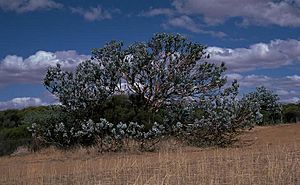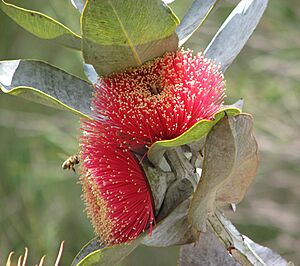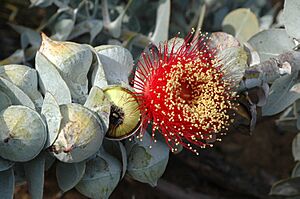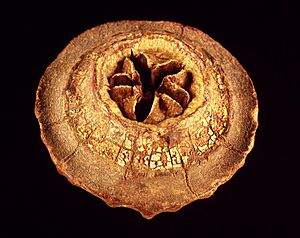Mottlecah facts for kids
Quick facts for kids Mottlecah |
|
|---|---|
 |
|
| Eucalyptus macrocarpa between Brookton and Corrigin | |
| Scientific classification | |
| Genus: |
Eucalyptus
|
| Species: |
macrocarpa
|
 |
|
| E. macrocarpa, field distribution | |
The Mottlecah (Eucalyptus macrocarpa) is a special type of eucalyptus tree that only grows in the south-west part of Western Australia. It has smooth bark and unique heart-shaped leaves that grow in pairs. You can easily spot it by its big, bright red flowers and large, cone-shaped fruits.

Contents
About the Mottlecah Plant
The Mottlecah is a type of mallee, which means it's a eucalyptus that grows like a shrub with many stems from the ground. It usually grows to be about 0.5 to 8 meters (1.6 to 26 feet) tall. This plant often spreads out wide and has a special woody swelling at its base called a lignotuber. This lignotuber helps it regrow after fires.
Leaves, Bark, and Flowers
The Mottlecah has smooth, shiny bark that can be brownish or salmon-pink. Its leaves are quite special. They are heart-shaped and grow in pairs directly on the stem, meaning they are sessile (they don't have a stalk). These leaves are also glaucous, which means they have a dull, blue-green, waxy coating. They are usually between 55 and 85 millimeters (2.2 to 3.3 inches) long and 35 to 50 millimeters (1.4 to 2.0 inches) wide.
The flower buds are also glaucous and grow one by one where the leaves meet the stem. Each bud sits on a short stalk called a peduncle, which is 1 to 7 millimeters long. The buds themselves are oval-shaped and quite large, about 40 to 55 millimeters (1.6 to 2.2 inches) long. They have a beak-shaped cap called an operculum that falls off when the flower opens.
Flowering and Fruit
Mottlecah flowers are usually bright red, but sometimes they can be creamy white. They bloom from August to January, or sometimes in April or June. After flowering, the plant produces large, woody, cone-shaped fruits. These fruits are also sessile (without a stalk) and are about 12 to 20 millimeters (0.47 to 0.79 inches) long and 33 to 45 millimeters (1.3 to 1.8 inches) wide. The parts that hold the seeds stick out above the edge of the fruit.
Naming the Mottlecah
The Mottlecah was first officially described in 1842 by a botanist named William Jackson Hooker. He studied a plant sample collected by James Drummond. Hooker wrote about it in his book, Icones Plantarum.
He noted that the bright red color of the flowers comes from their stamens (the parts that produce pollen), not petals. He also mentioned that the "bright red flowers nestled among the leaves" looked very striking. Local Indigenous people called this tree "morral."
What the Name Means
The scientific name macrocarpa comes from ancient Greek words. "Makros" (μακρός) means "long," and "karpos" (καρπός) means "fruit." So, macrocarpa means "long fruit," referring to its large fruits. The Noongar people, an Indigenous group, know this tree as "mottlecar."
Different Types of Mottlecah
In 1993, two scientists, Ian Brooker and Stephen Hopper, identified two slightly different types, or subspecies, of Mottlecah:
- Eucalyptus macrocarpa subsp. elachantha: This type has smaller leaves, buds, and fruits compared to the other subspecies. The name elachantha comes from ancient Greek words meaning "small flower."
- Eucalyptus macrocarpa subsp. macrocarpa: This is the more common type.
Where Mottlecah Grows
Mottlecah trees grow in sandy soil in rolling heathland areas. You can find them between the towns of Eneabba, Cataby, and Kulin in Western Australia. The subspecies elachantha is found in a smaller area, mostly south-east of Geraldton.
Protecting the Mottlecah
The subspecies macrocarpa is considered "not threatened," which means there are enough of them in the wild. However, the subspecies elachantha is listed as "Priority Four" by the Government of Western Australia's Department of Parks and Wildlife. This means it is rare or close to being threatened, so it needs special attention to protect it.
Growing Mottlecah Plants
Mottlecah is quite easy to grow from its seeds. However, it needs soil that drains water well and a dry climate without much frost. It was first grown from seeds in 1842 at Kew Gardens in England and flowered there in 1847.
Images for kids
-
E.macrocarpa x pyrformis
See also
 In Spanish: Eucalyptus macrocarpa para niños
In Spanish: Eucalyptus macrocarpa para niños





